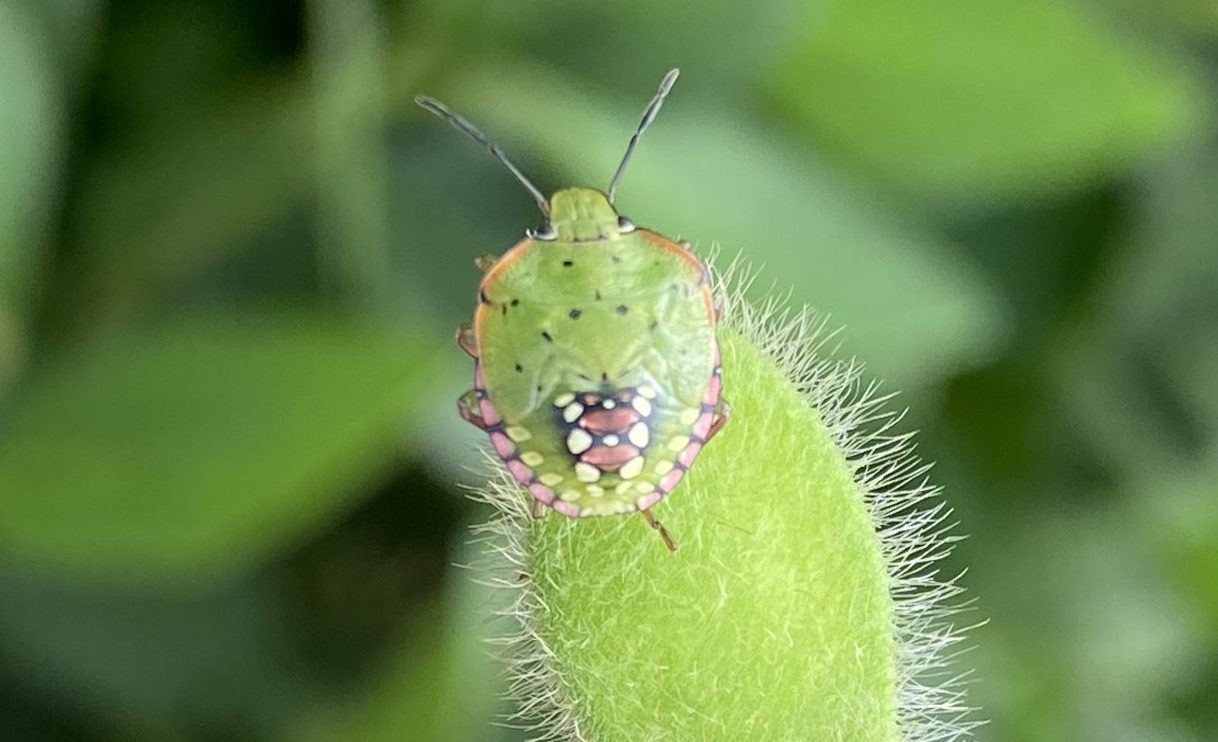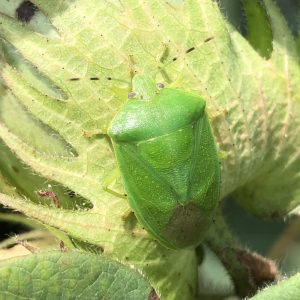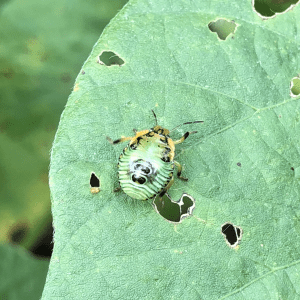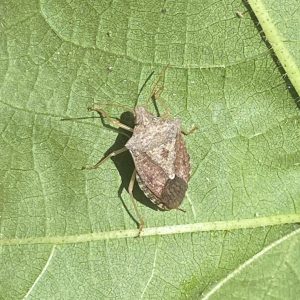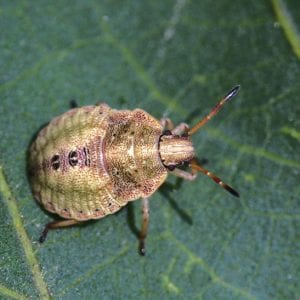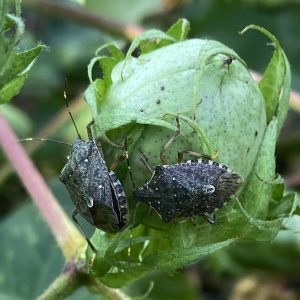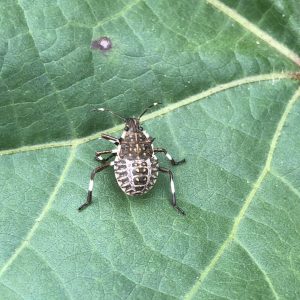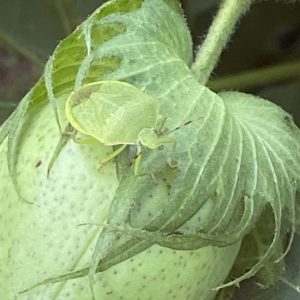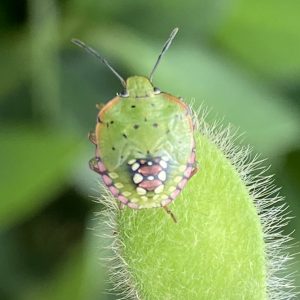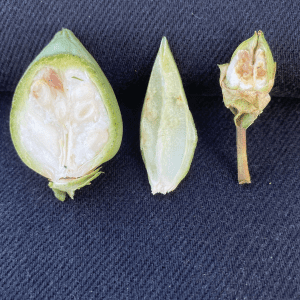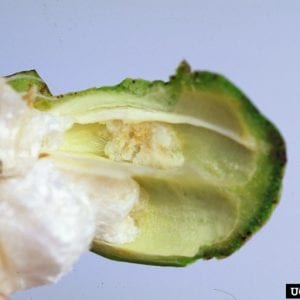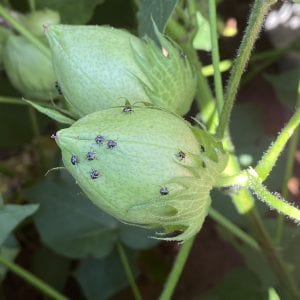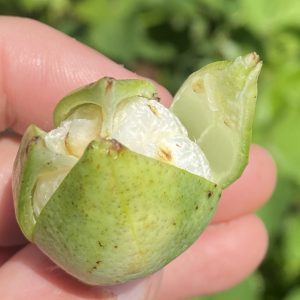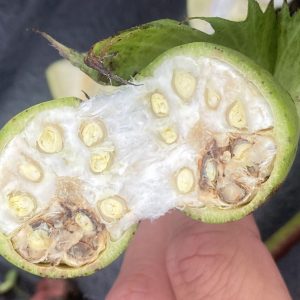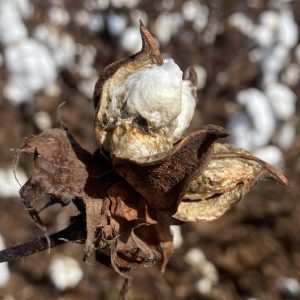Crop Production

Stink bugs are a consistent pest of cotton across Alabama. Understanding stink bug traits is key to managing infestations and mitigating crop damage.
Stink bugs (Hemiptera: Pentatomidae) are among the most yield-limiting insect pests of cotton in Alabama each year. A complex of species commonly infests cotton. Among these are the brown stink bug (Euschistus servus), green stink bug (Chinavia hilaris), southern green stink bug (Nezara viridula), and brown marmorated stink bug (Halyomorpha halys).
Although not a stink bug, the leaf-footed bug (Hemiptera: Coreidae Leptoglossus phyllopus), does similar damage to cotton and is commonly found in fields at the same time.
The brown, green, and southern green stink bugs make up the traditional species complex in Alabama. This group has long been established in the state and across the United States. The brown marmorated stink bug is an invasive pest native to Asia. This stink bug was first introduced in Alabama in 2010 and has since established in many cotton-producing counties across the state.
Distribution and Life Cycle
Stink bugs are polyphagous insects that prefer to feed on developing seeds of plants. In addition to cotton, stink bugs are commonly found on soybeans, corn, peanuts, tree fruits and nuts, various vegetables, grasses, and shrubs.
The stink bug life cycle begins as an overwintering adult in protected areas, such as under leaf litter, tree bark, dead weeds, outdoor buildings, and barns or in houses. Overwintering adults become active and move to host plants with overlapping seed and fruit production as temperatures begin to warm in the spring. As spring hosts begin to naturally senesce, stink bugs move into crop hosts, such as corn. After completing a generation in corn, stink bugs infest nearby cotton fields.
Stink bugs go through five nymphal instars before becoming adults. The complete life cycle from egg to adult takes 4 to 6 weeks depending on the species and time of year. The adult stage may live and do damage for 30 or more days.
Species Characteristics
Green Stink Bug
Adult green stink bugs are 1⁄2 to 3⁄4 inch in size and are a solid light green color (figure 1). Females are typically larger than males. Eggs are white and laid in groups of twenty to fifty. Immature green stink bugs hatch out with black bodies and orange markings and slowly mature to have a green body with a black head prior to becoming an adult (figure 2).
- Figure 1. Adult green stink bug
- Figure 2. Late instar immature green stink bug
- Figure 3. Adult brown stink bug
Brown Stink Bug
Adult brown stink bugs are roughly 1⁄2 inch in size and are a brown color with a yellow underside (figure 3). Eggs are yellowish and laid in masses of about sixty. Immature brown stink bugs are dark brown as hatchlings but mature to a dull green color prior to molting into an adult (figure 4).
Brown Marmorated Stink Bug
The brown marmorated stink bug adult ranges from 1⁄2 to 2⁄3 inch long. The adult is a brown-gray color with alternating white bands along its abdomen and antennae (figure 5). Eggs are whitish to pale green and laid in clusters of twenty to thirty. Freshly hatched immatures have a dark head with a reddish orange abdomen. As they develop, immature brown marmorated stink bugs become darker in color with distinct white bands on their legs and antennae (figure 6).
- Figure 4. Immature brown stink bug (photo: Russ Ottens, University of Georgia, Bugwood.org)
- Figure 5. Adult brown marmorated stink bugs.
- Figure 6. Immature brown marmorated stink bug
Southern Green Stink Bug
Southern green stink bug adults are a dull green color and 1⁄2 inch long with red bands on their antennae (figure 8). Eggs are white when laid and later turn pinkish just prior to hatching. They are laid in groups of up to 150. Freshly hatched immature southern green stink bugsare black. They mature to green with white spots ontheir abdomen and pink spots around the outer edge (figure 9).
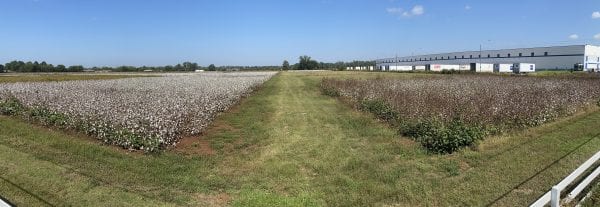
Figure 7. Effects of cotton managed for stink bugs (left) and not treated for stink bugs (right)
Pest Status
Stink bugs are a consistent pest of cotton across Alabama. Prior to the eradication of the boll weevil and the introduction of Bt cotton for the budworm/ bollworm complex, little attention was given to stink bugs as a serious pest. Stink bugs prefer to feed on young, developing thumb-size (about 1⁄2 inch diameter) to quarter-size (about 1 inch) bolls; however, stink bugs can damage bolls until bolls reach an outer diameter of about 1.25 inches (at least 25 days old).
Stink bugs target developing seeds within bolls and may cause a range of injury symptoms. External boll injury typically appears as dark purple to black sunken lesions. External symptoms may or may not be related to internal boll injury; thus, examining internal injury is necessary.
Bolls injured internally by stink bugs may have warts or small pinprick spots on the inside of the boll wall (figures 10 to 13). These pinprick spots may serve as an avenue to introduce boll rot organisms. Developing lint may be stained a tan, yellow, or brown color near a developing seed. Indications of this are often, but not always, located directly underneath outer stains and inner boll wall injury (figure 14). Injury from stink bugs may result in locks that are not harvestable, evidenced by hardlock bolls that fail to open or increased incident of boll rot pathogens entering developing bolls (figure 15).
- Figure 8. Adult southern green stink bug
- Figure 9. Immature southern green stink bug
- Figure 10. Internal injury symptoms caused by stink bugs
- Figure 11. Wart caused by stink bugs (photo: Ron Smith, Auburn University, Bugwood.org)
- Figure 12. Stink bugs on a cotton boll
- Figure 13. Warts and lint stains caused by stink bugs
- Figure 14. Cross section of lint and seed damaged by stink bugs
- Figure 15. Boll at harvest showing symptoms of stink bug damage
Management Strategies
Stink bugs tend to aggregate on field borders prior to moving into the rest of the field. Understanding the farmscape surrounding fields is important for stink bug management. Damage is often worse in smaller fields, which have more of a border effect than larger fields.
Stink bugs tend to infest cotton fields as corn begins to turn brown and is no longer a viable host. Similarly, stink bugs may infest cotton from nearby peanut fields all season long and from pecan trees or orchards when the shells begin to harden.
When scouting for stink bugs, the preferred method is to evaluate boll damage. Randomly select at least twenty-five quarter-sized (about 1 inch) bolls per field to evaluate. Samples should be made across the entire field and not just on the border (first 45 feet) to best understand the level of injury across the entire acreage. Visual observations, including drop cloth and/or sweep net samples, should not be relied on to estimate stink bug populations, as they are difficult to find in the field.
Current recommended thresholds and insecticide options for stink bugs can be found in Extension publication “Cotton: Insect, Nematode, and Weed Recommendations,” (IPM-0415).
Download a PDF of Pests of Alabama Cotton: Stink Bugs, ANR-2761.


